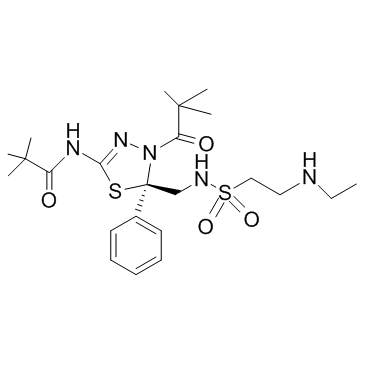Litronesib (formerly also known as LY2523355; LY-2523355; KF-8961) is a novel, potent and selective inhibitor of the kinesin-related motor protein Eg5 with potential anticancer activity. Litronesib specifically inhibits the activity of Eg5, which in actively dividing tumor cells may cause disruption of mitosis, apoptosis, and ultimately cell death. Additionally referred to as KIF11 or kinesin spindle protein-5, the ATP-dependent Eg5 kinesin-related motor protein is a plus-end directed kinesin motor protein that is crucial for the regulation of spindle dynamics, including assembly and maintenance, during mitosis. Look for open or closed clinical trials that are utilizing this agent. (NCI Lexicon).
Physicochemical Properties
| Molecular Formula | C23H37N5O4S2 |
| Molecular Weight | 511.7010 |
| Exact Mass | 511.229 |
| Elemental Analysis | C, 53.99; H, 7.29; N, 13.69; O, 12.51; S, 12.53 |
| CAS # | 910634-41-2 |
| Related CAS # | Litronesib Racemate;546111-97-1 |
| PubChem CID | 25167017 |
| Appearance | White to off-white solid powder |
| Density | 1.23 g/cm3 |
| LogP | 4.499 |
| Hydrogen Bond Donor Count | 3 |
| Hydrogen Bond Acceptor Count | 8 |
| Rotatable Bond Count | 11 |
| Heavy Atom Count | 34 |
| Complexity | 865 |
| Defined Atom Stereocenter Count | 1 |
| SMILES | C([C@]1(SC(NC(=O)C(C)(C)C)=NN1C(=O)C(C)(C)C)C1C=CC=CC=1)NS(=O)(=O)CCNCC |
| InChi Key | YVAFBXLHPINSIK-QHCPKHFHSA-N |
| InChi Code | InChI=1S/C23H37N5O4S2/c1-8-24-14-15-34(31,32)25-16-23(17-12-10-9-11-13-17)28(19(30)22(5,6)7)27-20(33-23)26-18(29)21(2,3)4/h9-13,24-25H,8,14-16H2,1-7H3,(H,26,27,29)/t23-/m0/s1 |
| Chemical Name | N-[(5R)-4-(2,2-dimethylpropanoyl)-5-[[2-(ethylamino)ethylsulfonylamino]methyl]-5-phenyl-1,3,4-thiadiazol-2-yl]-2,2-dimethylpropanamide |
| Synonyms | LY2523355; KF 89617; LY-2523355; KF89617; LY 2523355; KF-89617; Eg5 KinesinRelated Motor Protein Inhibitor |
| HS Tariff Code | 2934.99.9001 |
| Storage |
Powder-20°C 3 years 4°C 2 years In solvent -80°C 6 months -20°C 1 month |
| Shipping Condition | Room temperature (This product is stable at ambient temperature for a few days during ordinary shipping and time spent in Customs) |
Biological Activity
| Targets | Eg5 (IC50 = 14 μM) | |
| ln Vitro |
|
|
| ln Vivo |
|
|
| Cell Assay |
|
|
| Animal Protocol |
|
|
| References |
[1]. A Novel Eg5 Inhibitor (LY2523355) Causes Mitotic Arrest and Apoptosis in Cancer Cells and Shows Potent Antitumor Activity in Xenograft Tumor Models. Mol Cancer Ther. 2015 Nov;14(11):2463-72. |
|
| Additional Infomation |
Litronesib has been used in trials studying the treatment of Solid Tumors, Ovarian Cancer, Gastric Cancer, Prostate Cancer, and Acute Leukaemia, among others. Litronesib is an inhibitor of the kinesin-related motor protein Eg5 with potential antineoplastic activity. Litronesib selectively inhibits the activity of Eg5, which may result in mitotic disruption, apoptosis and consequently cell death in tumor cells that are actively dividing. The ATP-dependent Eg5 kinesin-related motor protein (also known as KIF11 or kinesin spindle protein-5) is a plus-end directed kinesin motor protein that plays an essential role during mitosis, particularly in the regulation of spindle dynamics, including assembly and maintenance. |
Solubility Data
| Solubility (In Vitro) | DMSO: ≥ 50 mg/mL (~97.7 mM) |
| Solubility (In Vivo) |
Solubility in Formulation 1: ≥ 2.5 mg/mL (4.89 mM) (saturation unknown) in 10% DMSO + 40% PEG300 + 5% Tween80 + 45% Saline (add these co-solvents sequentially from left to right, and one by one), clear solution. For example, if 1 mL of working solution is to be prepared, you can add 100 μL of 25.0 mg/mL clear DMSO stock solution to 400 μL PEG300 and mix evenly; then add 50 μL Tween-80 to the above solution and mix evenly; then add 450 μL normal saline to adjust the volume to 1 mL. Preparation of saline: Dissolve 0.9 g of sodium chloride in 100 mL ddH₂ O to obtain a clear solution. Solubility in Formulation 2: ≥ 2.5 mg/mL (4.89 mM) (saturation unknown) in 10% DMSO + 90% (20% SBE-β-CD in Saline) (add these co-solvents sequentially from left to right, and one by one), clear solution. For example, if 1 mL of working solution is to be prepared, you can add 100 μL of 25.0 mg/mL clear DMSO stock solution to 900 μL of 20% SBE-β-CD physiological saline solution and mix evenly. Preparation of 20% SBE-β-CD in Saline (4°C,1 week): Dissolve 2 g SBE-β-CD in 10 mL saline to obtain a clear solution. Solubility in Formulation 3: ≥ 2.5 mg/mL (4.89 mM) (saturation unknown) in 10% DMSO + 90% Corn Oil (add these co-solvents sequentially from left to right, and one by one), clear solution. For example, if 1 mL of working solution is to be prepared, you can add 100 μL of 25.0 mg/mL clear DMSO stock solution to 900 μL of corn oil and mix evenly. (Please use freshly prepared in vivo formulations for optimal results.) |
| Preparing Stock Solutions | 1 mg | 5 mg | 10 mg | |
| 1 mM | 1.9543 mL | 9.7714 mL | 19.5427 mL | |
| 5 mM | 0.3909 mL | 1.9543 mL | 3.9085 mL | |
| 10 mM | 0.1954 mL | 0.9771 mL | 1.9543 mL |
